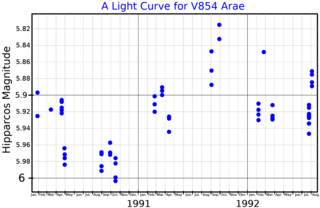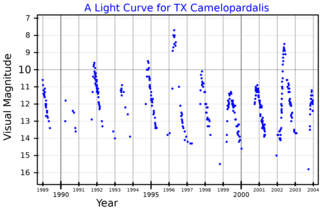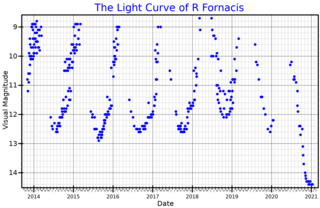21 Cancri is a double star in the northern zodiac constellation of Cancer. It is just visible to the naked eye as a dim, red-hued star with an apparent visual magnitude of 6.08. The star is located around 791 light years away from the Sun, based on parallax. It is moving further from the Earth with a heliocentric radial velocity of 35 km/s.

V385 Andromedae is a variable star in the constellation Andromeda, about 360 parsecs (1,200 ly) away. It is a red giant over a hundred times larger than the sun. It has an apparent magnitude around 6.4, just about visible to the naked eye in ideal conditions.

LP Aquarii is a pulsating variable star in the constellation of Aquarius that varies between magnitudes 6.30 and 6.64. The position of the star near the ecliptic means it is subject to lunar occultations.

HD 155035 is a star in the constellation Ara, the Altar. It is located at a distance of approximately 1,450 light-years from Earth and has an apparent visual magnitude of 5.92, making it is faintly visible to the naked eye. This is a red giant star with a stellar classification of M1.5 III. It an irregular variable that changes brightness over an amplitude range of 0.12 magnitudes.

R Arae is an Algol-type eclipsing binary in the constellation Ara. Located approximately 298 parsecs (970 ly) distant, it normally shines at magnitude 6.17, but during eclipses can fall as low as magnitude 7.32. It has been suggested by multiple studies that mass transfer is occurring between the two stars of this system, and the period of eclipses seems to be increasing over time. The primary is a blue-white main sequence star of spectral type B5V that is 5 times as massive as the Sun, while the secondary is a yellow-white star of spectral type F1IV that is 1.5 times as massive as the Sun. Stellar material is being stripped off the secondary and accreting on the primary.

W Andromedae is a variable star in the constellation of Andromeda. It is classified as a Mira variable and S-type star, and varies from an apparent visual magnitude of 14.6 at minimum brightness to a magnitude of 6.7 at maximum brightness, with a period of approximately 397.3 days. The star is losing mass due to stellar winds at a rate of 2.79×10−7M☉/yr.

TX Camelopardalis is a Mira-type variable star in the constellation Camelopardalis. It is a classical long period variable star with pulsational period of 558.7 days. Water masers have been observed around the star.
9 Equulei is an M-type star in the constellation Equuleus. It is an asymptotic giant branch (AGB) star, a star that has exhausted its core helium and is now fusing both hydrogen and helium in shells outside the core. It is also a suspected variable star with an amplitude of about 0.05 magnitudes.
HD 91496 is a giant star in the constellation Carina, with an apparent magnitude is 4.92 and an MK spectral class of K4/5 III. It has been suspected of varying in brightness, but this has not been confirmed.

Sigma Ophiuchi, Latinized from σ Ophiuchi, is a single, orange-hued star in the equatorial constellation Ophiuchus. Its apparent visual magnitude is 4.31, which is bright enough to be faintly visible to the naked eye. The annual parallax shift of 3.62 mas as seen from Earth provides a distance estimate of roughly 900 light years. It is moving closer to the Sun with a radial velocity of −28 km/s.

31 Orionis is a binary star system in the equatorial constellation of Orion, located near the bright star Mintaka. It is visible to the naked eye as a faint, orange-hued point of light with a baseline apparent visual magnitude of 4.71. The distance to this system is approximately 490 light years away based on parallax, and it is drifting further away with a mean radial velocity of +6 km/s.

QZ Puppis is a class B2.5V star in the constellation Puppis. Its apparent magnitude is 4.5 and it is approximately 650 light years away based on parallax.

R Geminorum is a Mira variable and technetium star in the constellation Gemini. It is located approximately 850 parsecs (2,800 ly) away.

W Coronae Borealis is a Mira-type long period variable star in the constellation Corona Borealis. Its apparent magnitude varies between 7.8 and 14.3 over a period of 238 days.

U Microscopii is a Mira variable star in the constellation Microscopium. It ranges from magnitude 7 to 14.4 over a period of 334 days. The Astronomical Society of Southern Africa in 2003 reported that observations of U Microscopii were very urgently needed as data on its light curve was incomplete.

V Antliae is a Mira variable star in the constellation Antlia. It varies in brightness between magnitudes 8.2 and 14.0 with a period of 303 days.

HD 65750, also known as V341 Carinae is a bright red giant star in the constellation Carina. It is surrounded by a prominent reflection nebula, known as IC 2220, nicknamed the Toby Jug Nebula.

S Cassiopeiae is a Mira variable and S-type star in the constellation Cassiopeia. It is an unusually cool star, rapidly losing mass and surrounded by dense gas and dust producing masers.

MZ Puppis is a red supergiant star in the constellation of Puppis. It has a radius of 400 R☉.

R Fornacis is a Mira variable and carbon star located in the constellation Fornax. It is around 1,800 light years away based on parallax measurements.

















